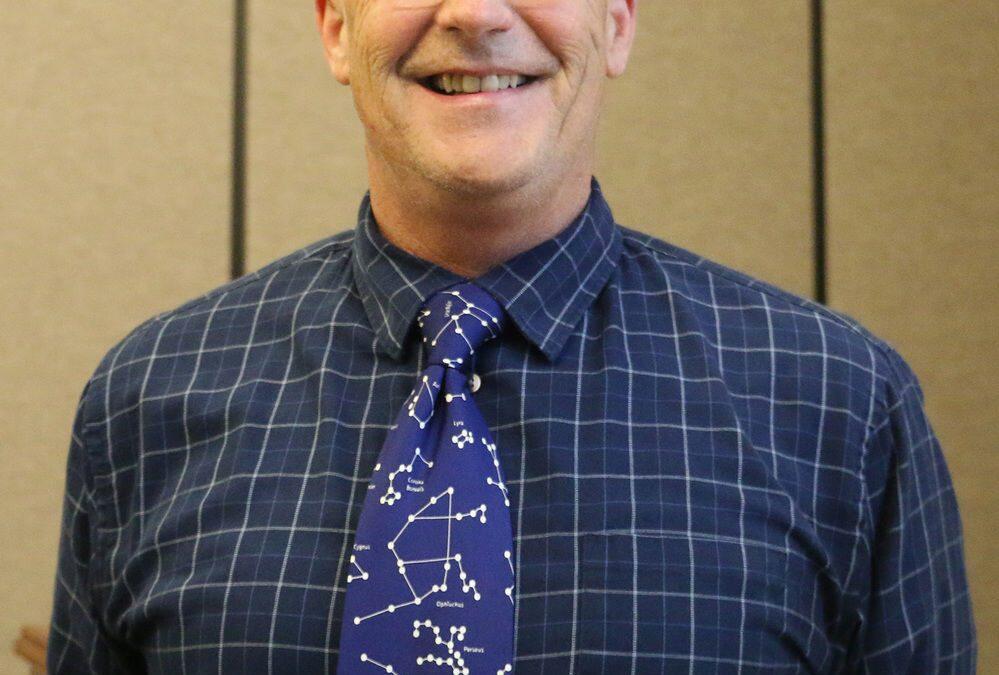Members of the Business Club got a lesson in science and astronomy on Wednesday as the community continues to prepare for the total solar eclipse on Aug. 21.
Tom Robinson, astronomy instructor at Western Nebraska Community College, talked about the rare event and what residents and visitors can expect during the solar eclipse.
“A solar eclipse can occur only at a new moon, but not every new moon produces a solar eclipse,” Robinson said. “As earth’s moon orbits the sun throughout the year, the moon’s orbital tile changes direction relative to the sun.”
A total eclipse of the sun occurs when the moon passes between the Earth and the Sun, casting its shadow on the Earth’s surface. The umbra, or narrow path of the full shadow, is where the moon completely covers the sun and viewers see a total solar eclipse.
It is predicted the moon’s shadow will travel across the United States in about 90 minutes. NASA visualizer Ernie Wright has created maps to calculate where the total solar eclipse will occur using knowledge that neither the earth or the moon are smooth or spherical, different elevations on earth, relative positions of each celestial object and data from the lunar reconnaissance orbiter to create a digital map of elevation on the moon. Maps are based on every factor Wright could as accurate as possible.
“People will rely on these maps of predicted location,” Robinson said. “Everything in it is driven by the data.”
The totality of the solar eclipse is the time when the moon completely covers the sun.
“It’s something a lot of people can’t compare to anything else,” he said.
Robinson also spoke about the importance of safety during the event.
“A really important thing is you can’t look at the sun except for that little bit of time when it’s covered,” he said.
While the one minute, 48 seconds of totality will go quickly, Karla Nieden-Streeks, executive director, Gering Convention and Visitors Bureau, cautioned people to think about their eyesight.
“The bad thing is your retina has no feeling, so you have to be very careful when you’re looking at the sun,” she said.
When the first fragment of light from the sun appears after totality, it is recommended viewers put their glasses back on or look away.
During totality, stars and the naked eye planets will be visible.
“You will need to look quickly because a minute and forty-eight seconds isn’t a lot of time,” Nieden-Streeks said.
In order to view the solar eclipse, it is important to protect your eyes. This can be done with a pinhole camera, eclipse viewer, welder’s glass or eclipse glasses.
“One thing to keep in mind is solar glasses are delicate,” he said. “If they’re scratched a little bit they’re no good anymore.”
Robinson provided examples of other ways to see a solar eclipse, such as looking at the shapes coming out of the trees, which viewers should be able to see crescents from the sun, or a shoe box with a pinhole.
“Just looking at the environment around you, you’ll see a lot of different things,” he said. “You’ll notice why ancient humans were frightened by such things.”
Members of the Business Club worried the weather would not cooperate during the day, but Robinson assured them it was predicted to be a hot and clear day.
“But, you never know,” he said. “We always have that one stray Cumulonimbus cloud that wants to come around.”
It is expected people are traveling to locations in Wyoming and Nebraska because of its weather and the chance for a clear day.
“The only thing that could stop it from happening is if our sun went supernova,” he said. “My guess is it’s going to be a beautiful day.”
Rain or shine, the eclipse will happen. Nieden-Streeks said she had one suggestion for the public.
“Our charge to all of you is to hit the prayer rug, rosary, whatever you need to make it happen,” she said.
Between 3,000 and 10,000 visitors are expected to descend on the Panhandle for the event. International scientific delegations from 19 countries will be here to see the solar eclipse. Two teams from NASA will also be in the area, though it’s not known which locations they will be at yet.
“This is a tremendous opportunity to welcome national and international visitors who will look at our area during a once in a lifetime event,” she said. “We want to showcase our community in the best possible light.”
Source: http://bit.ly/2oQyuZA











